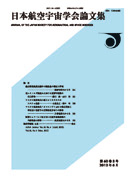All issues

Volume 65 (2017)
- Issue 6 Pages 219-
- Issue 5 Pages 177-
- Issue 4 Pages 137-
- Issue 3 Pages 103-
- Issue 2 Pages 41-
- Issue 1 Pages 1-
Volume 65, Issue 4
Displaying 1-5 of 5 articles from this issue
- |<
- <
- 1
- >
- >|
Paper
-
Akihiro MAEKAWA, Masahiko YAMAKAMI, Syouhei KITAHARA2017 Volume 65 Issue 4 Pages 137-142
Published: 2017
Released on J-STAGE: August 05, 2017
JOURNAL FREE ACCESSIt is reported that a control augmentation system (CAS) with a fuzzy neural network (FNN) controller for an aircraft is robust against various flight conditions. This paper describes the evaluation of the optimality of the FNN learning results based on the internal structure of the FNN control unit, and the simulation results of its control performance. We conclude that internal structure of the FNN control unit is approximately composed of gain and offset and that the gain and the offset obtained by the learning FNN can reduce the learning error to 0, i.e. FNN carries out the optimal learning. Furthermore, we have confirmed that if the rate of the aileron and the rudder may saturate, the controller composed of the gain and the offset obtained by the FNN is more robust than apply the FNN controller directly.View full abstractDownload PDF (2001K) -
Masashi HARADA2017 Volume 65 Issue 4 Pages 143-150
Published: 2017
Released on J-STAGE: August 05, 2017
JOURNAL FREE ACCESSIn this paper, the practical design method of the maximum static thrust rotor based on the vortex method is described. After the vortex method is introduced, the simplified optimum rotor design method is presented. By analyzing the shape of the rotor wake, it was evident that the pitch of the vortices produced by the tip of the rotor is half that of the inboard vortices. The wake contraction rate parameter and axial vortex trajectory parameters are obtained from the tip vortices simulation. The accurate design method based on the vortex method with accurate wake model is then executed. The obtained maximum thrust rotor satisfies the conditions required on the Trefftz plane, which is not unfulfilled achieved by the simplified design method.View full abstractDownload PDF (2290K) -
Koji MIYAJI, Tota UENO, Yasumi KAWAMURA2017 Volume 65 Issue 4 Pages 151-156
Published: 2017
Released on J-STAGE: August 05, 2017
JOURNAL FREE ACCESSThis study investigates the performance of an intrusive polynomial chaos expansion (PCE) method in the uncertainty quantification (UQ) of CFD. Quasi one-dimensional flow of a transonic nozzle with an uncertainty in the exit-pressure condition is discussed. Two major numerical techniques in our intrusive PCE are Roe-variable transformation and the multi-element (ME) PCE for clear implementations and improved accuracies of the UQ code for the case with a discontinuity (shock wave). The Roe's flux difference splitting scheme for the augmented equations has a clear advantage in resolutions against a simpler scheme while the discontinuity in the stochastic space is not properly treated by the polynomial approximation. The ME-PCE has been shown quite effective to simulate a complex stochastic response. The results are compared with Monte Carlo simulations and the reliability of the developed method is verified.View full abstractDownload PDF (6334K) -
Yuji SAITO, Toshiki YOKOI, Ayumu TSUJI, Kazunobu OMURA, Hiroyuki YASUK ...2017 Volume 65 Issue 4 Pages 157-167
Published: 2017
Released on J-STAGE: August 05, 2017
JOURNAL FREE ACCESSIn this study, the authors conducted twice experiments to verify the throttling characteristics of axial-injection end-burning hybrid rockets. Oxidizer mass flow rate and chamber pressure were throttled by actuating valves in a fluid circuit consisting of two oxidizer supply lines. Chamber pressure and oxidizer mass flow rate were measured during each firing. The results show that oxidizer to fuel ratio remains constant for similar values of oxidizer mass flow rate. However, two weak points were identified in these throttling firing tests. First, a pressure transient was observed when oxidizer mass flow rate was increased (turn-up operation). The pressure transient consisted of two distinguishable first order lags, a fast lag followed by a slow lag, which are treated by separate curve fitting functions. The fast response is explained by a thermal lag in the solid fuel, whereas the slow response requires further inquiry. Second, the chamber pressure history exhibited hysteresis characteristics of oxidizer mass flow rate due to the increasing fuel regression rate. Therefore, in the throttling tests where oxidizer flow rate was turned-up and returned to the initial condition twice back-to-back, the chamber pressure history was higher in the second iteration than in the first.View full abstractDownload PDF (2933K) -
Go FUJIWARA, Yasuto SUNADA, Kenichi RINOIE2017 Volume 65 Issue 4 Pages 168-175
Published: 2017
Released on J-STAGE: August 05, 2017
JOURNAL FREE ACCESSTo investigate quasi-periodic behavior of laminar separation bubble near airfoil stall, instantaneous surface pressure distributions of NACA0012 airfoil were measured. Reynolds number based on the airfoil chord length was 1.3 × 105 and the measured angles of attack were 11.3º, 11.6º and 12.0º. At α = 11.6º, the flow around the airfoil indicated quasi-periodical switching behavior between an attached flow with laminar separation bubble (short bubble) and a large separated flow at a frequency of about 2Hz. At α = 11.3º, the flow attaches to the airfoil for a longer period and switches between these two flow patterns irregularly. At α = 12.0º, two different flow phases were observed. One is the phase when the flow switches between the large separated flow and the attached flow with short bubble. At the other phase which was observed longer than the first phase, the flow oscillates without forming the short bubble. Wavelet analysis was performed on the instantaneous surface pressure distributions. Results indicated that pressure fluctuations at frequency of 20--40Hz were observed when the flow was switching from an attached flow with short bubble to large separated one. These fluctuations were observed for all the three tested angles of attack.View full abstractDownload PDF (2317K)
- |<
- <
- 1
- >
- >|